
What is Cable Railing
Cable railings (also known as cable railing systems and wire rope railings) are a low maintenance alternative to traditional wood or metal railings.
Quite simply, they are guard rails and hand rails that use horizontal cables in place of traditional spindles, glass, mesh, etc. for infill.
Cable rail offers modern design properties by utilizing metal posts and handrails, but can also be combined with wood stair parts for a hybrid custom style.
Stainless steel cable rail is a popular choice for both interior and exterior railing because of its anti-weathering durability, reasonable cost, and strong luxurious appeal.
For this reason, cable railing is used in many commercial and industrial buildings, as well as in marine and aquatic settings.
Types of Cable Railing Systems
| Features | Metal Cable Railing System | Wood Cable Railing System |
|---|---|---|
| Style | Modern, Minimalistic | Traditional, Modern |
| Used for Interior Projects | Yes | Yes |
| Used for Exterior Projects | Yes | Yes |
| Ideal for Stairways, Decks, Docks, Patios, and More | Yes | Yes |
| Uses 5/32-inches Marine-Grade 316L Stainless Steel Cable | Yes | Yes |
| Maximum Space Between Posts | 4-ft | 8-ft with Intermediate Post Necessary Every 4-ft |
| Uses Intermediate Posts | No | Yes |
| Compatible Handrail Materials | Aluminum, Stainless Steel, Wood | Aluminum, Stainless Steel, Wood |
| Compatible Tensioning / Fastening Kits | Level / Angle Tension Kit, KeyMount Kit | DriveTite Kit, Wood Level / Angle Tension Kit |
| Fasteners / Tensioners Hidden Within Posts | Yes | Yes |
Posts construction
Due to the excessive load requirements of this type of railing system, post construction is critical to the success of cable railings.
Cable railing requires very rigid frames compared to many other types of railings due to the forces applied to the end posts by tensioning the cables. Cables must be tensioned to provide minimum cable deflection using 4-inch sphere, to satisfy building code requirements.
Manufacturers use different methods to achieve the same result, one manufacturer uses a thicker wall and a webbed post in their aluminum systems, while using only thicker side walls in their stainless systems. Common frame types are constructed of steel, stainless steel, extruded aluminum or wood.
Posts height
The total minimum height required varies per building codes depending on the area and target use of either residential or commercial. Local city codes supersede state, national and international code. In most states, the residential code is 36 inches high.
There are some exceptions, though, like in California the required height for residential railing is 42 inches.
On the other hand, the commercial International Building Code requires the railing to be at a minimum of 42-inch height.
Posts can be floor-mounted or fascia/side-mounted, but the height of the railing is measured from the floor to the top of the railing.
Spacing between the cables
The nationwide construction code requires that any opening should be less than 4 inches, and no 4-inch sphere should pass. In cable railing the target opening is usually less than 3 1⁄2 inches, taking into account the cable’s deflection when a 4-inch ball is forced to go through the cables.
In order to meet this requirement, typically the number of parallel cables for 36-inch-high railing is 10, and 12 for 42-inch-high railing for floor-mounted posts.
Cables and tensioning
Cable is very strong in tensile strength, with a breaking strength in excess of 1000 lbs for these types of uses, and is a suitable in-fill material for a railing (“guard” in ICC codes). Typical diameters are 1/8″, 3/16″ for residential and 3/16″ and 1/4″ for commercial applications.
There are many different types cable and strand (also referred to as wire rope). Cable and strand is available in galvanized carbon steel, type 304 stainless steel, or the highly corrosion resistant, type 316 stainless steel (best for coastal areas).
The most common cable construction is 1×19 type construction strand, which is 19 cables twisted in a single bundle, whereas for example, 7×7 would be 7 cable bundles of 7 cables twisted. This type of stainless strand is designed to have limited stretch, as compared to galvanized, making it a good long term cable railing solution.
It has long been used for yacht stays and guy wires, proving its outdoor durability and strength.
What is Cable flexibility in Cable Raling?
Cable flexibility is an important consideration in designing a cable railing. The old UBC (Uniform Building Code) and newer ICC (IBC and IRC) codes state that a 4” sphere shall not pass through any portion of a barrier on a guardrail.
In a horizontal or vertical cable rail, the cables, once tensioned must be rigid enough to prevent a 4-inch sphere passing through it. Factors influencing this rigidity are: the tension of the cable, intermediate posts (or cable spacers) spacing, the diameter of the cable, top rail cap material and the cable to cable spacing.
The application of the 4″ sphere test is usually at the discretion of a code enforcement official who will interpret the force behind the 4″ sphere so it is advised that cable spacing not be more than 3″ over a 48″ space between post.
Cable tension
An incredible amount of tension is generated on the end posts when ten or more cables, each tensioned at 200-400 lbs. over a height of 36″ to 42” exists. Underestimating the tension of cables applied to end poles can cause a safety hazard.
Cable can have too much deflection allowing body parts to slip through, or cables can merely “pull out” of the end fittings, causing the cable rail to fail. Poorly designed end posts will result in a railing where the cables cannot be properly tensioned without an unacceptable amount of cable deflection. End posts to which the tensioning hardware attaches must be constructed so that they will not deflect perceptibly.
Post spacing
Intermediate posts are posts which provide mounting for the top rail and have a vertical row of holes to support the cable as it passes through them. Since the post to post spacing is a primary driver of cable rigidity, the post to post spacing is very important.
It is generally recommended that post spacing be no more than 5 ft on center Some manufacturers require as little as no more than 3 ft on center.
The reason for post spacing is more about the cable end fittings’ machine thread loading capacity (how much tension can be put on the threads before they fail), than anything else.
The more cable drop in the middle, the more weight on the tensioning device, ergo the more load on the threads. Proof strength must be greater than load.
Cable diameter and properties
The next variable is the diameter of the cable. Cables can be any wire rope, which meets load strength requirements by the ICC. The most available types are 1×19 1/8″, 1 x 19 5/32″, 1×19 3/16″, 7×7 3/16″ and 1×19 1/4″.
1 x 19 cable is the most rigid cable available and per the first paragraph above will have greater resistance to the 4″ sphere test and likewise have a lesser chance of allowing objects 4″ and over to slip through the cable. 316 Stainless Steel is preferred, due to its inherent nature against stretching, keeping long term maintenance down, as well as having anti-corrosive properties.
Top rail
Top rail material must be strong as it is being compressed by the combined cable forces.
Common top cap materials are the stronger species of wood or metal. Composite lumber can be used if a support rail is used along with it. The support rail is used between the posts to lend strength to the system, both between the posts, and to the Top Rail.
Cable to cable spacing
Spacing of the cables vertically is critical to minimize deflection of the cables. Most manufacturers recommended maximum vertical spacing of no more than 3-inch free opening between cables when they are installed to meet cable deflection requirements as stated above.
All of the above factors work together to minimize the deflection of the cable to prevent a 4” sphere from passing between the cables when they are properly tensioned in a well-designed frame.
This is a requirement according to a number of building codes. Among the more stringent, including that of California, this requirement may be used in conjunction with a weight being hung from the cable.
Cable end fittings
Cable end fittings are the pieces that tie the system together. The cable attaches into one side of the fitting, while the other side attaches to the post (frame structure). Cable ends may tension, or just attach to the frame, depending on the individual needs of the project.
The requirements needed to decide whether to use tensioning or non-tensioning fittings are generally dependent upon the manufacturer’s system requirements, your local building codes, and ICC requirements.
To determine the type of cable end fittings needed, you’ll need to know the distance you expect a single piece of cable to run without stopping, and the amount of tensioning ability of the fitting you expect to use.
Individual manufacturers will help you to determine the rest.














